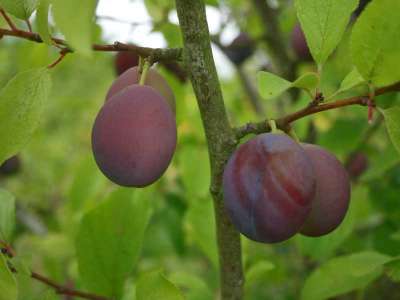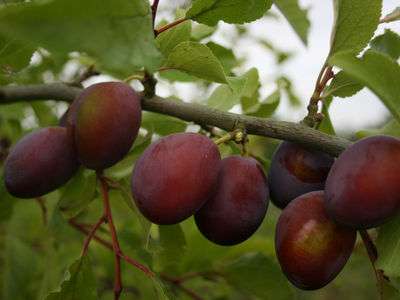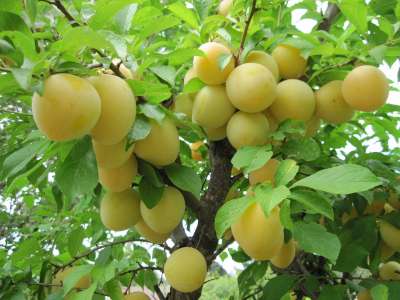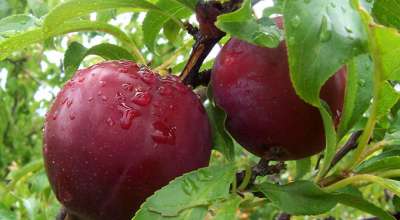Your basket is currently empty!
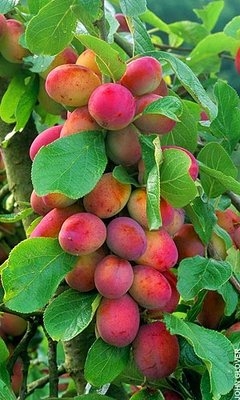
A plum tree is simply a wonderful thing to have in the garden. The value lies in the huge crops that can be achieved year after year with minimal intervention once the formative years have been passed. Plums are so versatile in their uses, yes the ultimate pleasure comes with eating them straight from the tree and still warm from the sun! But few fruits suit freezing better, and jars of plum jam will see you smugly through the winter time too.
Our large wide range of quality Plum trees.
Plum varieties are quite varied; although the classic Victoria will undoubtedly spring to most peoples minds’ first, the pale coppery red oval fruits of this variety have come to epitomise ‘plum’ to most people. But the fruits of many varieties can be considerably larger, or petite, circular, or oblong. And they are certainly not just red, skin colour varies from a pale primrose yellow to an almost black, several are a combination shades inbetween. The skin colour often belies flavour characteristics from the flesh within. Some are culinary specialists with a wonderful tart and powerful flavour – just brilliant for pies and preserves. And others are more benign, delicate, honeyed, sugary and light, some almost toffee-apple like in character when fully ripe. Although you can cook with any plum varieties it is these latter types that are best if you prefer to enjoy plums staright from the tree. Whatever your preferences if you can grow more than one tree then be sure to select some nice variations so you have plums suited to all purposes and tastes.
When choosing a site for plum trees, it’s worth noting that they flower very early. Infact they are the earliest of all the fruit trees to come into blossom, apart from Apricots. For this reason it’s worth finding them a more sheltered spot. The tree itself is pretty hardy and will do well everywhere but the mass of small snowy white blossoms can be frost damaged and it’s during these years that the fruits will be much more scarce. Some varieties have a degree of blossom frost-tolerance and these are worth considering for more Northerly locations but even these will give so much more if they are shown consideration in siting. Culinary varieties are in general hardier and more prolific than the dessert ones are.
The closely allied Greengage trees are included in this article as all cultivation methods are the same. But if anything they require more warmth and shelter and are less suited to cold districts. Again hardier kinds can be highlighted but for the best results bear this in mind before choosing your spot.
The plum tree season
Can extend for several weeks so to gain the most from these fruits try to grow a selection of varieties that ripen over the greatest length of time. In England the first ripe fruits can be had from late July [Early Laxton, Opal, Czar] And the very latest varieties can carry them into October [Marjories Seedling] The bulk – or ‘glut’ – is normally through August and early September.
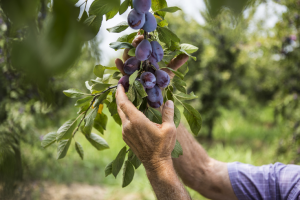
Growing methods for Plum trees
The bush tree is undoubtedly the most productive and often-grown method for Plum trees. Depending on the rootstock chosen the size can vary from 7-14’ or more and there are plenty of options to make sure the tree is size-suited to your needs. A bush tree will usually have some trunk clearance so it can be mown beneath, or if grown in a border it is suitable to grow flowers or herbs beneath the tree. Crops are the heaviest of all the growing methods described. So if you are looking for trees for a traditional orchard, or smaller sized specimens for a garden, then read about the rootstocks available which will tell you how big the trees will grow.
The column growing method
Is similar to a cordon. These trees are very easy to prune and maintain and take up the smallest amount of ground space of any tree. As might be expected the trees just grow straight up and the side shoots are kept trimmed back to maintain the slender columnar shape. The trees only need pruning once a year and the leader can also be controlled so the tree grows no more than 6-8’ in height. These trees are easy to harvest and because they cast little shade are ideal for growing in a mixed border, as well as in pots. And because they do not spread at all they are often also used to grow alongside a path or walkway, or grown in a line as a divider in the garden or as a perimeter marker. Plant just 2.5’ apart; colunn plum & gage trees are invariably grafted onto the compact Pixy stock.
Fan trained Plums
If you have a suitable fence or wall then the fan shaped tree comes into it’s own. These very flat trees hug the wall and the elegant shape – the outline of which is quite like a geisha fan or doves-tail – is most attractive. Because of the shelter that is afforded in such locations, crops are heavy and regular and frost damage is not usually an issue. You will need an area of 6-8’ in height, and the same in width, for a fan shaped plum or gage. The fence or wall should ideally face south or west. A North facing aspect us not suited to fan training plums or gages. An east facing wall or fence might be suitable for one of the hardier cooking varieties. One point to remember is that the soil in such positions can be quite dry especially if it tends to be sheltered from prevailing rains – be sure to keep a check to make sure it is suitable for growing a tree and if it appears dry irrigate regularly for some months before planting, as well as after, to ensure the best results.
A Stepover tree
Is a growing method that has achieved prominence relatively recently. It is usually associated with apples and pears but plums and gages have been shown to grow equally well as a stepover tree. These quaint little trees are really very small; they can perform a decorative function in the garden and are both novel and enjoyable to grow. Crops are understandably quite light but as the fruits receive the maximum amount of sunshine, the flavour is often wonderful.
A step-over achieves no more than 18” in height and has only two laterals which spread out either side of the main stem, in the shape of a capital ‘T’ It is called a stepover because this specialist little tree is normally used to edge a border or pathway and is low enough simply to ‘step over’They need a good soil to perform well [don’t try to grow them where it is too dry or the soil is thin] and attention should be given to make sure they do not become overcrowded by neighbouring plants. A spacing of about 5’ between trees is about right and they should grow to meet at the tips creating a continuous line or border. You will need a top wire supported by two posts either end on which to tie down the laterals, at least for the first year or two, as otherwise the tendency is for these laterals to grow upwards. They are quite pliable at such a young age and it is easy to keep them tied down. After 2 or 3 years the wires can usually be removed.
Stepovers can be bought ready or part-trained, or you can start yourself from scratch with a young tree – it is quite easy to do. They are always on the Pixy rootstock; the more vigorous rootstocks are not suited to this growing method.
Plums and gages can also be festooned in the manner of cherry trees. This method involves tying the leader and main side branches down to a wire supported by a peg in the ground. This forms a lovely semi-weeping shaped tree, It isn’t quite as easy to do as it is with cherries because the branches are not quite as pliable, but it is a worthwhile project for the gardener with a little more experience in fruit tree growing. A festooned Plum treewill often yield earlier in life than many other growing methods and achieves a nice naturally compact habit.
Espalier Plums Trees
Plums are not normally grown as espalier; this is a growing method reserved for apples and pears. If you want a nice wall-trained Plum or Gage tree then refer to the details for fan-training above.
Plum Rootstocks – an introduction & guide!
As with all rootstocks Plums and Gage trees are grafted [or budded depending on the time of year] on to a rootstock – an entirely different tree that influences the growth – vigour or otherwise – of the plum tree concerned. The rootstock isn’t really visible, except as the root itself but it discretely plays a very important part in the development of your tree. It is important that you choose the stock that is best suited to your needs so you don’t end up with an entirely unsuitable tree – a pygmy dwarf is of no more use in your traditional orchard or paddock than a large vigorously growing tree would be in a pocket handkerchief sized plot or patio pot!
St Julien ‘A’ rootstock
Is the most prevalent and often grown rootstock and is compatible with all plums, gages and damson trees. It is reasonably vigorous but not uncontrollably so and it suits most soils including those that aren’t quite so good. Trees can grow to 10-15’ depending on soil and cultivar, the spread is usually slightly less than this. Crops are very heavy and this remains the most recommended stock for wherever there is room. Larger gardens, lawn, paddockl grassland and orchard are all ideal situations and the trees can be mown beneath with ease. It can make a good half standard or be grown as a bush tree. Usually trees on St Julien stock start to bear fruit in about 3 years although this can be less. St Julien is the preferred choice for fan training.
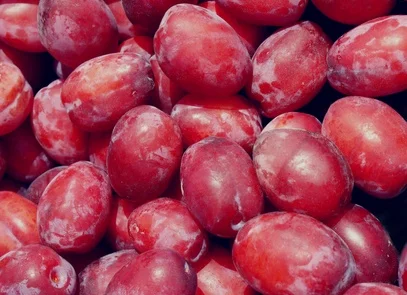
Pixy stock
This makes a truly dwarfing tree and is now the most popular choice for general garden growing. Trees on this stock can be controlled to 8’ or even less, the spread is slightly less than this. Pixy is ideal for large containers and column growing, stepover, as well as for making a dwarf bush. Not really suitable for mowing beneath but good for small garden, patio, or a mixed border or fruit cage. Along with most dwarf rootstocks, does not easily make a good fan. Pixy rootstock requires good soil conditions to give of it’s best and light or sandy soils will need improving before planting. It is important that this stock never gets too dry. Pixy is precocious – often starts to yield earlier than any other stock.
Brompton and cerasifera [wild plum] stocks
These are big, big trees! Once they were in favour for traditional orchards but even in these situations St Julien has taken over. These stocks are very hardy and good for less ideal situations but harvesting is difficult as so much of the fruit is out of reach. They may still have a place where old-style trees are required and in large, open situations. Mature size is 18-20’ or more with a spread only marginally less. Suckering can be an issue in the formative years. Production normally starts in around 4-5 years.
Wanghenheimer Plum Tree
Is a stock favoured in Germany but it can also be sourced in this country sometimes. It is relatively compact with a size reduction of 20% or so over St Julien. It is hardy and productive, usually coming into bearing in 2-3 years but can be slow to make good growth in the early stages. There have been compatibility issues with some varieties on our nursery.
Plumina Plum stocks
Is a relatively recent introduction and the rootstocks themselves are difficult to acquire hence trees on this stock are not often available. It certainly shows promise with a dwarfing habit comparable to Pixy, precocious early in life and promoting a large fruit size. Suitable as a bush tree, container work and also a column or stepover.



